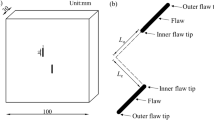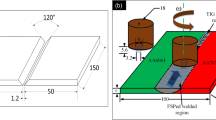Abstract
Current researches of acoustic emission (AE) mainly put the focus on fault diagnosis of traditional isotropic materials machining process or analysis of fiber-reinforced composite (FRC) tensile or bending strength, while there are merely studies on AE research of FRC grinding process. Numerous kinds of damage occur during FRC grinding process owing to their complicated structure. The main purpose of this paper is to extract proper index to estimate AE signals of FRC grinding and to recognize damage patterns, thus realizing FRC processing on-line detection. AE signals are obtained by single-grain grinding experiments of quartz fiber–reinforced silicon dioxide matrix composite (SiO2/SiO2). The AE signal features are discussed, and the outstanding character of frequency components is proposed. The frequency of each damage pattern is analyzed and verified. AE effective voltage value (EVV) and event number percentage (ENP) of peak frequency (PF) of AE signals with processing parameters are researched. The results show that for the same kind of FRCs, frequency components of AE signals are only affected by damage patterns rather than processing parameters or grinding directions, thus being a proper estimate index. There are four main frequency bands during SiO2/SiO2 grinding. The frequency 6.4–9.8 KHz corresponds to fiber fracture, 14.8–17.9 KHz is fiber debonding, 23.6–26.4 KHz is debris rubbing with workpiece and tool, and 34–35.5 KHz is matrix crack. EVV has a similar changing trend to grinding force with machining parameters. AE ENP of PF that the maximum peak amplitude (PA) corresponds to could quantitatively confirm the main damage modes under each processing condition.
Similar content being viewed by others
Change history
14 May 2019
The original version of this article contained a mistake. The arrows and lines in Figs. 1(a) and 5 are missing.
References
Grabec I, Kuljanić E (1994) Characterization of manufacturing processes based upon acoustic emission analysis by neural networks. CIRP Ann 43(1):77–80. https://doi.org/10.1016/S0007-8506(07)62168-4
Hundt W, Leuenberger D, Rehsteiner F, Gygax P (1994) An approach to monitoring of the grinding process using acoustic emission (AE) technique. CIRP Ann 43(1):295–298. https://doi.org/10.1016/S0007-8506(07)62217-3
Badger J, Murphy S, O’Donnell GE (2018) Acoustic emission in dressing of grinding wheels: AE intensity, dressing energy, and quantification of dressing sharpness and increase in diamond wear-flat size. Int J Mach Tools Manuf 125:11–19. https://doi.org/10.1016/j.ijmachtools.2017.11.007
Karpuschewski B, Wehmeier M, Inasaki I (2000) Grinding monitoring system based on power and acoustic emission sensors. CIRP Ann 49(1):235–240. https://doi.org/10.1016/S0007-8506(07)62936-9
Wang Z, Willett P, DeAguiar PR, Webster J (2001) Neural network detection of grinding burn from acoustic emission. Int J Mach Tools Manuf 41(2):283–309. https://doi.org/10.1016/S0890-6955(00)00057-2
Surgeon M, Vanswijgenhoven E, Wevers M, Van Der Biest O (1997) Acoustic emission during tensile testing of SiC-fibre-reinforced BMAS glass-ceramic composites. Compos A: Appl Sci Manuf 28(5):473–480. https://doi.org/10.1016/S1359-835X(96)00147-9
Favre JP, Laizet JC (1989) Amplitude and counts per event analysis of the acoustic emission generated by the transverse cracking of cross-ply CFRP. Compos Sci Technol 36(1):27–43. https://doi.org/10.1016/0266-3538(89)90014-6
Li L, Swolfs Y, Straumit I, Yan X, Lomov SV (2016) Cluster analysis of acoustic emission signals for 2D and 3D woven carbon fiber/epoxy composites. JCoMa 50(14):1921–1935. https://doi.org/10.1177/0021998315597742
Ativitavas N, Fowler TJ, Pothisiri T (2004) Identification of fiber breakage in fiber reinforced plastic by low-amplitude filtering of acoustic emission data. JNE 23(1):21–36. https://doi.org/10.1023/B:JONE.0000045218.22048.7a
Surgeon M, Wevers M (1999) Modal analysis of acoustic emission signals from CFRP laminates. NDT & E International 32(6):311–322. https://doi.org/10.1016/S0963-8695(98)00077-2
Azadi M, Sayar H, Ghasemi-Ghalebahman A, Jafari SM (2019) Tensile loading rate effect on mechanical properties and failure mechanisms in open-hole carbon fiber reinforced polymer composites by acoustic emission approach. Compos Part B 158:448–458. https://doi.org/10.1016/j.compositesb.2018.09.103
Li B, Ding W, Yang C, Li C (2018) Grindability of powder metallurgy nickel-base superalloy FGH96 and sensibility analysis of machined surface roughness. Int J Adv Manuf Technol. https://doi.org/10.1007/s00170-018-3117-0
Qian N, Ding W, Zhu Y (2018) Comparative investigation on grindability of K4125 and Inconel718 nickel-based superalloys. Int J Adv Manuf Technol 97(5):1649–1661. https://doi.org/10.1007/s00170-018-1993-y
Dai C-W, Ding W-F, Zhu Y-J, Xu J-H, Yu H-W (2018) Grinding temperature and power consumption in high speed grinding of Inconel 718 nickel-based superalloy with a vitrified CBN wheel. Precis Eng 52:192–200. https://doi.org/10.1016/j.precisioneng.2017.12.005
Wang J, Yu T, Ding W, Fu Y, Bastawros AF (2018) Wear evolution and stress distribution of single CBN superabrasive grain in high-speed grinding. Precis Eng 54:70–80. https://doi.org/10.1016/j.precisioneng.2018.05.003
Liu S, Chen T, Wu C (2016) Rotary ultrasonic face grinding of carbon fiber reinforced plastic (CFRP): a study on cutting force model. Int J Adv Manuf Technol:1–10. doi:https://doi.org/10.1007/s00170-016-9151-x
Li ZC, Jiao Y, Deines TW, Pei ZJ, Treadwell C (2005) Rotary ultrasonic machining of ceramic matrix composites: feasibility study and designed experiments. Int J Mach Tools Manuf 45(12–13):1402–1411. https://doi.org/10.1016/j.ijmachtools.2005.01.034
Wang Y, Sarin VK, Lin B, Li H, Gillard S (2016) Feasibility study of the ultrasonic vibration filing of carbon fiber reinforced silicon carbide composites. Int J Mach Tools Manuf 101:10–17. https://doi.org/10.1016/j.ijmachtools.2015.11.003
Xiao X, Zheng K, Liao W, Meng H (2016) Study on cutting force model in ultrasonic vibration assisted side grinding of zirconia ceramics. Int J Mach Tools Manuf 104:58–67. https://doi.org/10.1016/j.ijmachtools.2016.01.004
Li H, Lin B, Wan S, Wang Y, Zhang X (2016) An experimental investigation on ultrasonic vibration-assisted grinding of SiO2f/SiO2 composites. MMP 31(7):887–895. https://doi.org/10.1080/10426914.2015.1090586
Webster J, Dong WP, Lindsay R (1996) Raw acoustic emission signal analysis of grinding process. CIRP Ann 45(1):335–340. https://doi.org/10.1016/S0007-8506(07)63075-3
Gregory N, Morscher NG (2014) Use of acoustic emission for ceramic matrix composites. In: Ceramic matrix composites. https://doi.org/10.1002/9781118832998.ch20
Wei J, Wang H, Lin B, Sui T, Zhao F, Fang S (2018) A force model in single grain grinding of long fiber reinforced woven composite. Int J Adv Manuf Technol:1–12. doi:https://doi.org/10.1007/s00170-018-2719-x
Wang H, Wang Y, Lin B, Wei J, He Y, Zhao F, Fang S (2018) What roles do ceramic matrix and woven fibers have in bending strength of SiO2/SiO2 composites: an experimental investigation and acoustic emission analysis. Ceram Int. https://doi.org/10.1016/j.ceramint.2018.09.295
Gong T, Geng R (2002) Parameter analysis method of acoustic emission signal. NDTE 24 (2)
Wei J, Wang H, Lin B, Sui T, Zhao F, Fang S (2019) A force model in single grain grinding of long fiber reinforced woven composite. Int J Adv Manuf Technol 100(1):541–552. https://doi.org/10.1007/s00170-018-2719-x
Nair A, Cai CS (2010) Acoustic emission monitoring of bridges: review and case studies. Eng Struct 32(6):1704–1714. https://doi.org/10.1016/j.engstruct.2010.02.020
Kang X, Xi Z (2007) Size effect on the dynamic characteristic of a micro beam based on Cosserat theory. Jixie Qiangdu/Journal of Mechanical Strength 29(1):1–4
Kong S, Zhou S, Nie Z, Wang K (2008) The size-dependent natural frequency of Bernoulli–Euler micro-beams. IJES 46(5):427–437. https://doi.org/10.1016/j.ijengsci.2007.10.002
Lam DCC, Yang F, Chong ACM, Wang J, Tong P (2003) Experiments and theory in strain gradient elasticity. J Mech Phys Solids 51(8):1477–1508. https://doi.org/10.1016/S0022-5096(03)00053-X
Shi YS, Wang YG, Yang Y, Sun LP, Lin B (2011) Analysis on ground surface damage of quartz fiber-reinforced quartz composites. Appl Mech Mater 80–81:266–270. https://doi.org/10.4028/www.scientific.net/AMM.80-81.266
Acknowledgement
During the course of paper writing, thanks very much for the valuable suggestions from a young teacher Shuai Yan. His comments on this research is important. I am deeply influenced by his rigorous attitude to research and working manner in daily life.
Funding
This work was financially supported by the National Natural Science Foundation of China (NO.51375333).
Author information
Authors and Affiliations
Corresponding author
Additional information
Publisher’s note
Springer Nature remains neutral with regard to jurisdictional claims in published maps and institutional affiliations.
The original version of this article was revised: The arrows and lines in Figs. 1(a) and Fig. 5 are missing.
Rights and permissions
About this article
Cite this article
Wei, J., Wang, H., Lin, B. et al. Acoustic emission signal of fiber-reinforced composite grinding: frequency components and damage pattern recognition. Int J Adv Manuf Technol 103, 1391–1401 (2019). https://doi.org/10.1007/s00170-019-03645-x
Received:
Accepted:
Published:
Issue Date:
DOI: https://doi.org/10.1007/s00170-019-03645-x




